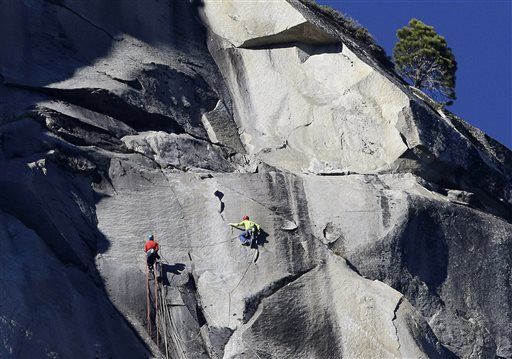2 friends climb into history by their bloodied fingertips
Published 10:00 am Friday, January 16, 2015
YOSEMITE NATIONAL PARK, Calif. (AP) — American rock climber Tommy Caldwell was first to pull himself atop a 3,000-foot sheer granite face in Yosemite National Park, followed minutes later by his longtime friend Kevin Jorgeson.
The pair embraced and then Jorgeson pumped his arm in the air and clapped his hands above his head. After years of practice, failed attempts and 19 grueling days scaling the vertical wall on El Capitan by their bloodied fingertips, the friends at last grasped success.
“That’s a deep, abiding, lifelong friendship, built over suffering on the wall together over six years,” said Caldwell’s mother, Terry, among some 200 people in the valley floor thousands of feet below who broke into cheers at the climbers’ historic feat Wednesday.
She said her son could have reached the top of the world’s largest granite monolith several days ago, but he waited for his friend to ensure they made it together.
The men completed what had long been considered the world’s most difficult rock climb, captivating the world through social media and livestreamed video coverage while documentary filmmakers dangled from ropes capturing each move.
Caldwell, 36, and Jorgeson, 30, became the first to free-climb the rock formation’s Dawn Wall, a feat many had considered impossible. They used ropes and safety harnesses in case of a fall but relied entirely on their own strength and dexterity to ascend by grasping cracks as thin as razor blades and as small as dimes.
The two dealt with constant falls and injuries. But their success completes a yearslong dream that bordered on obsession.
Jorgeson said Thursday on Good Morning America that it was great so many people found their journey inspirational.
“It’s pretty surreal to wake up and have the climb complete; it’s pretty hard to describe,” said Jorgeson of Santa Rosa, California.
Caldwell of Estes Park, Colorado, spoke only briefly, saying he lost his voice calling out to his friend, but described the climb as “an incredible experience.”
President Barack Obama sent his congratulations from the White House Twitter account, saying the men “remind us that anything is possible.”
The trek began Dec. 27. Caldwell and Jorgeson lived on the wall itself, eating and sleeping in tents fastened to the rock thousands of feet above the ground and battling painful cuts to their fingertips much of the way.
Free-climbers do not pull themselves up with cables or use chisels to carve out handholds. Instead, they climb inch by inch, wedging their fingers and feet into tiny crevices or gripping sharp, thin projections of rock. In photographs, the two appeared at times like Spider-Man, with arms and legs splayed across the pale stone that has been described as smooth as a bedroom wall.
Both men needed to take rest days to heal. They used tape and even superglue to help protect their raw skin. At one point, Caldwell set an alarm to wake him every few hours to apply a special lotion to his throbbing hands.
They also endured physical punishment whenever their grip slipped, pitching them into long, swinging falls that left them bouncing off the rock face. The tumbles, which they called “taking a whipper,” ended with startling jolts from their safety ropes.
Caldwell and Jorgeson had help from a team of supporters who brought food and supplies and shot video of the adventure.
The pair ate canned peaches and occasionally sipped whiskey. They watched their urine evaporate into the thin, dry air and handed toilet sacks, called “wag bags,” to helpers who disposed of them.
There are about 100 routes up the rock known among climbers as “El Cap,” and many have made it to the top, the first in 1958. Even the Dawn Wall had been scaled. Warren Harding and Dean Caldwell (no relation to Tommy) made it up in 1970, using climbing ropes and countless rivets over 27 days.
No one, however, had ever made it to the summit in one continuous free-climb — until now.
“He doesn’t understand the magnitude of the accomplishment and the excitement generated,” said Caldwell’s father, Mike Caldwell.
The pioneering ascent comes after five years of training and failed attempts for both men. They only got about a third of the way up in 2010 when stormed turned them back. A year later, Jorgeson fell and broke an ankle in another attempt. Since then, each has spent time on the rock practicing and mapping out strategy.
This time, as the world watched and followed on Facebook and Twitter, Jorgeson was stalled in a lower section that took 11 attempts over seven days.
“I didn’t want to accept any other outcome but getting up that route,” Jorgeson said on Good Morning America. “I tried to push all the negative thoughts of not being able to do it out and picture getting across that traverse, and that’s eventually what happened.”






